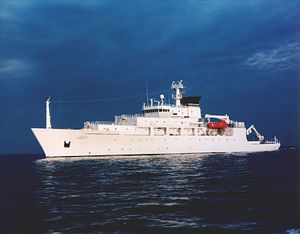On Friday, U.S. defense officials announced that a Chinese naval vessel had seized a U.S. unmanned underwater naval probe, lifting it from the water despite the protests of the U.S. vessel (the USNS Bowditch) that was attempting to collect the probe.
On Saturday, the Pentagon announced that China had agreed to return the buoyancy glider, which is used to monitor ocean conditions. On Sunday, a statement from China’s defense ministry confirmed that, with spokesperson Yang Yujun saying China would “hand over the U.S. underwater drone it captured in its waters to the United States in an appropriate manner,” according to Xinhua. Yang also scolded the United States for making the incident public, saying it was “not helpful.”
The phrase “its waters,” referring to China’s waters, is particularly alarming. As Ankit pointed out yesterday, the incident took place 50 nautical miles northwest of Subic Bay — well within the Philippines’ Exclusive Economic Zone, and seemingly outside of China’s nine-dash line claim (although the claim has never been made with any geographical precision, so it’s impossible to say for certain where China believes the nine-dash line begins and ends). Given that, the claim that the Chinese naval vessel was acting within Chinese waters will only add fuel to fears that Beijing intends to claim the entirety of the South China Sea as its own personal lake.
However, it’s important to note that Yang himself does not use the phrase in his original Chinese statement; he merely refers to the “relevant waters of the South China Sea.” Xinhua added the descriptor “its waters” in its English-language report.
As for the rationale behind seizing the probe in the first place, Yang explained the incident as follows:
[O]n the afternoon of December 15, a Chinese naval lifeboat located an unidentified device in the waters of the South China Sea. In order to prevent the device from causing harm to the safety of navigation and personnel of passing vessels, the Chinese naval lifeboat verified and examined the device in a professional and responsible manner.
This would seem to directly contradict the U.S. account, which has the crew of the Bowditch contacting the Chinese vessel and repeatedly informing the crew that the “unidentified device” was, in fact, U.S. property. Given that the Bowditch was in the process of retrieving the probe when the Chinese vessel captured it, it also seems unlikely that there was any real concern about the device “causing harm to the safety of navigation.”
Indeed, China’s real motive seems quite clear later on in Yang’s statement, when he reiterates that “China resolutely opposes” U.S. surveillance activities “within Chinese waters” and “demands that the U.S. side should stop such activities.” U.S. military surveillance close to China has long been one of three main complaints routinely brought up in discussions by Chinese defense officials (with the other two being U.S. arms sales to Taiwan and restrictions on high-tech exports to China).
By capturing the probe, China seems to be signalling it is prepared to take more aggressive action to end such surveillance. “China will continue to be vigilant against the relevant activities on the U.S. side, and will take necessary measures in response,” Yang said.
However, by couching its move not as a direct attempt to counter U.S. surveillance but as a selfless attempt to protect maritime safety China is trying to kill two birds with one stone. Beijing can send an unprecedented signal to the United States about the steps China’s navy is willing to take to stop surveillance. At the same time, however, China can also hold itself up a the guarantor of high seas freedom and safety — a role long played by the United States, but one which China would greatly like to take over in the Western Pacific.
































